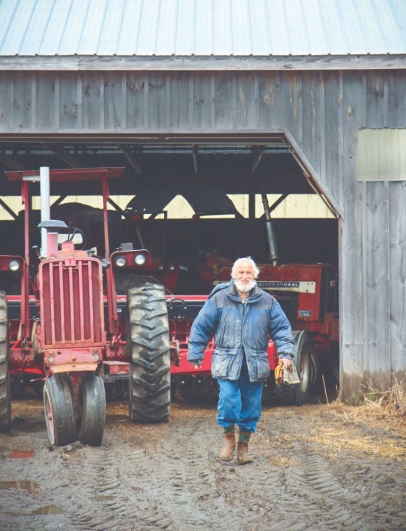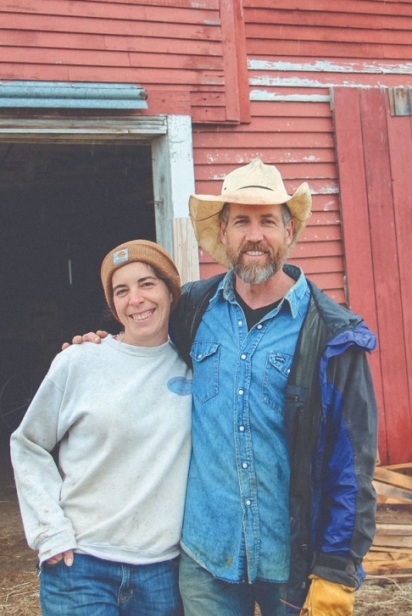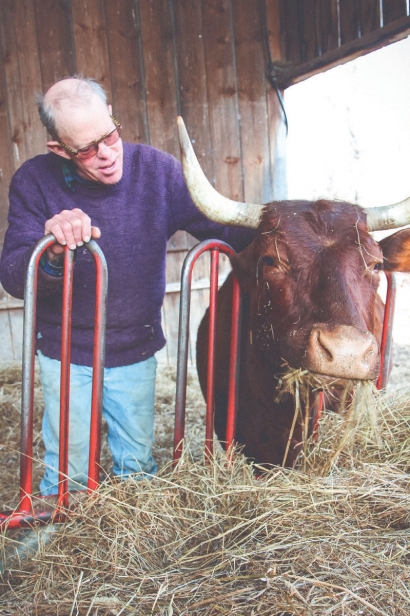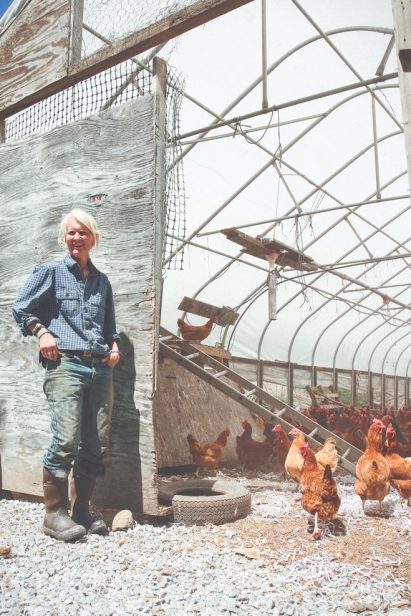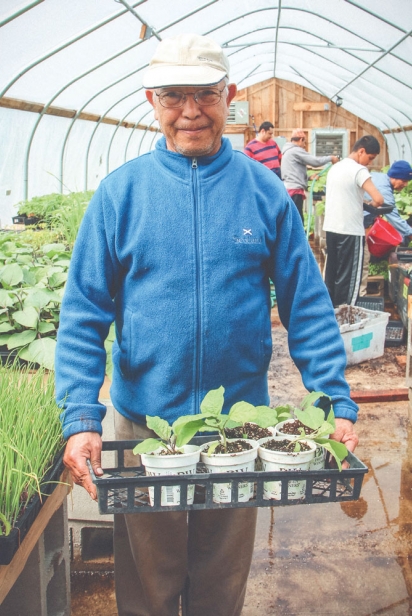Paying It Forward: Veteran Sustainable Agriculturalists Share Wisdom with the Next Generation
As seasoned farmers we have to help bring on the next generation, more so than any other occupation,” said Scout Proft, 52, founder and primary caretaker of Someday Farm, a 185-acre diversified farm in East Dorset.
Scout’s spunk and energy are magnetic. Even the farm animals, like the dogs that trot by her feet, are drawn in.
And it’s no wonder: Scout’s vision is impressive. Starting as the first community-supported agriculture (CSA) harvest subscription program in Vermont in 1984, today Someday Farm grows 100 varieties of crops; raises 600 range-running laying hens, 3,000 pheasants, 1,000 meat chickens and 500 turkeys; stewards 120 acres of sustainably managed woodlands; and runs a community-based commercial composting operation.
I follow Scout in and around various spots on the farm—from a small retail area to vegetable greenhouses, a processing room to farm-to-school activity areas.
“Farming is the most challenging occupation there is,” Scout says, projecting her voice over a few hundred chickens. “You have to know so much in one profession: we have to be doctors, lawyers, communicators, teachers and more. If we can make the next generation’s job a little easier with what’s gone right and what’s gone wrong, they can be more efficient and effective … and hopefully stay in the profession that everyone needs.”
One of the lessons Scout shares with the many young farmers she’s taken under her wing is diversify your operation. Scout is teaching her son, Eben, and Mara Hearst, both in their 20s and partners of Someday Farm, as well as others she meets through her roles as program administrator of the Northeast Organic Farming Association of Vermont (NOFA-VT) Collaborative Regional Alliance for Farmer Training (CRAFT) and as a NOFA-VT Farm to Community Mentor.
While the dominant market economy favors specialization, diversification is an important means of economic resilience, what Scout calls the “farm’s insurance policy.” For example, Someday Farm lost 3,000 pheasants one year because a grain company sold them moldy grain and refused to take responsibility. But since they also raise turkeys and the turkeys were healthy, their community business was unharmed by the feed problem. Likewise, since Scout grows 18 varieties of greens, it doesn’t matter if kale is going out of style and pea shoots are coming in. She’s always prepared to supply whatever her shareholders and local chefs ask for.
Someday Farm is one of five farms I’m visiting to learn the practical knowledge and values—in short, the wisdom—that Vermont’s experienced sustainable growers are passing forward. I’m spending my weekends winding Vermont’s rural landscape and thinking about the moment in farming history we’re in. With 300 years of collective farming experience, the men and women I am speaking with learned from farmers ahead of them, while developing their own, often unique, farming practices.
The farmers before them did the same. And the young farmers being mentored now will presumably follow suit—building on these veteran farmers’ practices while further refining it with their own visions.
I set out on the road because I feel an urgency to listen to and collect veteran farmers’ stories and expertise. Vermont’s farming population has been steadily aging. It now averages 57 in Vermont, 58 nationwide, and those entering today’s consolidating market are faced with immense challenges and risks. Though I am no longer on track to farm myself, I am there in spirit, invested in the well-being of young and veteran farmer friends and in the success of the good farming movement. Perhaps what motivates me most is the importance and timelessness of veteran farmers’ wisdom and the process of passing this inspiration across occupational, familial and generational lines.
About 70 miles northeast of Someday Farm is Cedar Mountain Farm, a partially horse-powered farm part of the 23-home Cobb Hill Cohousing in Hartland. I feel like I’ve arrived in some version of heaven where community is united through food and farming.
Stephen Leslie and Kerry Gawalt are the practically minded duo at the helm of Cobb Hill Cohousing’s community-supported agriculture. With the help of a small crew and four small, handsome working horses called Fjords, descended from the Vikings and mountainous regions of Norway, Stephen and Kerry grow vegetables, make hay, milk cows and raise beef and young heifer cows. Though, like Scout, Stephen and Kerry are relatively young to be considered veteran farmers at 52 and 39, respectively, each has 20+ years of farming experience. Mentors themselves, Stephen is the author of The New Horse Powered Farm (Chelsea Green), Kerry is a teacher at the University of Vermont’s New Farmer Project, and both work with youth farmers through the local 4-H Club. While mentors, Stephen and Kerry continue to learn from an eclectic set of farmers, including Eric Nordell, a Pennsylvania Amish farmer famous in the horse farming world, and others in the dairy industry.
I hang out at the hitching post and ask Stephen and Kerry questions as they load equipment onto working horses, Cassima and Tristan, getting ready to till a field for planting onions. With dark manes on blond muscular bodies, the Fjords manage to look regal in the rain, patiently awaiting work.
When guiding new farmers, Stephen and Kerry say that they first address the question “whether or not to farm” before “how to best farm.” The couple reminds me that, like any job, love of the work is key to farming. Thinking about the positions that I have held, I know there can be a difference between idealism and the reality of the work. In farming, it seems, this difference can be especially stark.
Stephen and Kerry say they often see a disconnect in the young people who approach them with an interest in farming with horses. Having spent even just an afternoon with their Fjords, I restrain myself from proclaiming that I may have discovered my calling to be a horse farmer. Stephen cautions farmers: “Ask, ‘Do you love working with plants and animals? Is this something you want to do 70 hours a week?’ If not, farming might not be a good fit for you. There are easier ways of making money. Ultimately what will keep you in it is the love of it.”
But Stephen also hopes young people will have his love of farming and be willing to dedicate themselves to the lifestyle: “This is a new vision of society … you can’t have culture without agriculture. We farm because we want to transform [agriculture to be more sustainable] and be part of the solution.”
Due north of Cedar Mountain Farm in the hinterlands of Vermont, I reach Butterworks Farm’s 350 acres in Westfield. My excitement arriving is coupled with anticipation to meet legends Jack and Anne Lazor. Famous for pioneering organic grain production, Jack, 63, farms while working on his second Chelsea Green book, Letter to a Young Farmer, and teaching young farmers as a plant and soil science lecturer at the University of Vermont. Anne, 62, who also farms full-time, is a noted herbalist and sought-out mentor in homeopathic and other alternative animal therapies.
We sit near their woodstove over hot bowls of freshly made carrot-ginger soup, Butterworks cream and whole-wheat bread, welcome heat from the brisk weather outside. Jack and Anne tell me about the conventional growers they’ve learned from and how they’ve adapted these practices to grow grain organically—what put them on the map in the agriculture world. They talk about why they prioritize mentoring young farmers second only to caring for their health, which has recently been of concern.
“However long I’m going to be around,” Jack tells me, “I want to share the knowledge I’ve gained in the last 40 years.” Anne adds, “We know what works for us, but the times are changing, so we’re trying to pass down wisdom that is hopefully timeless about human nature, the way the marketplace works, the way the soil works … There are so many different aspects that we’ve picked up … that gives us a perspective that others might not have.”
Judging from the immediate warmth they conveyed when I met them for the first time, I don’t doubt them when they tell me they help every farmer who approaches them with a question.
The principal advice I hear at Butterworks Farm, the largest operation I am visiting for this story, is for farmers and others growing businesses: Follow your values and be intentional about scale. Jack and Anne say there’s a sweet spot—not too big, not too small. Jack warns beginning farmers, “Suppress your tendencies towards grandiosity. Don’t get carried away with wanting to be everything to everybody or be really big—economically big—because it just doesn’t really go with the territory [of farming].”
If Jack and Anne started farming all over again, they say, they would have kept their farm small, milking, say, six Jersey cows and selling their much-adored yogurt door-to-door and at farmers’ markets instead of shipping to stores throughout the Northeast as part of a $1,250,000 business. Bigger—unless you’re mega big—in the farming world does not mean there will be more capital for retirement. Instead, it means less time and resources spent within one’s community. Real wealth and success, they believe, is not what it appears to be in mainstream culture.
“If you want to know what our farm tastes like,” Jack motions to the fridge, “take a spoonful of Jersey yogurt right off the top with the cream on it. It’s got that nutty flavor … it’s a little tangy. It’s got kind of a French butter taste to it. To me, that’s the esoteric quality indicator.”
Above all things—profit, fame and otherwise—Jack and Anne value upholding the culture of agriculture, being food sovereign—or defining their own food systems and producing healthy and culturally appropriate foods, and promoting the health of their community—people, animals, plants, soil and atmosphere.
About an hour west of Butterworks, I arrive at Flack Family Farm, a 385-acre biodynamic operation tucked in the hills of Enosburg Falls. The farm produces a range of foods, what Doug and Barbara Flack call “medicine”: fermented vegetables, milk, grass-fed meats, eggs and herbal tinctures. I only had to meet their Devon milking cows, a hardy breed of cattle formerly used by the ancient Romans, with their horns fully intact (uncommon for dairy animals but prized in biodynamics for their energetics), to know that I wasn’t on your average farm.
Trained in ecology, Doug took his PhD in an unusual direction 36 years ago by founding Flack Family Farm. Barbara, a retired schoolteacher, married Doug and joined the farm with her two children 14 years ago. For Doug, elderhood hasn’t been about retirement but shifting gears. He still works 15-hour days, managing his farm of many pieces and taking the time to pass his ideas and knowledge on. While continuing to diversify and grow Flack Family Farm, Doug is transitioning it to successors Anna Powell, 34, and Vidar Zay, 28, and imparting his expertise to a wide audience through writing and workshops.
“Chronic in our culture is to not pay attention to people who figure out something that’s very important,” Doug says when I ask him about what advice he’s sharing with young farmers. Doug could as easily be talking about himself as his food and farming influences: Rudolf Steiner, William Albrecht, Weston A. Price, among others.
Doug chucks miscellaneous boulders and tree limbs out of fields as we walk. If I hadn’t asked, I wouldn’t have guessed he was 72, more like a decade younger. He’s the kind of person I listen to when he talks about the keys to good health. Doug encourages young farmers—and all of us—not to ignore alternative, undervalued perspectives. Foundational to rejuvenating human culture and health away from chronic illness and disease, Doug tells me, is the revitalization of land, community, and art. Healthy cultures start with healthy farms and farming techniques. All of this begins with the soil, which should be rich with macronutrients, micronutrients and diverse organisms.
I meet three Bhutanese refugee farmers—Saran Chhetri, 68, Ashok Dahal, 68, and Leela Luitel, 53—in their Winooski greenhouse, shared amongst refugees from Bhutan, Burundi and Somalia through the Association of Africans Living in Vermont’s (AALV) New Farms for New Americans program. It’s cool outside but we work up a sweat as the captured sun turns to heat.
Pioneer rice farmers in the Green Mountain State, Saran, Ashok and Leela’s goal is bold: for Vermont to produce all of its own rice, a crop that is routinely bought in from outside the United States, even among dedicated locavores. The Bhutanese farmers are as generous with their time and dedicated to mentoring young farmers in Vermont as the American-born farmers I’m getting to know. Saran, Ashok and Leela teach not only young people in Vermont’s Bhutanese community but also refugees from other countries and Vermonters interested in learning about farming rice and other ethnically important crops.
Speaking through a translator named Anil Shrestha, Saran, Ashok and Leela tell me about the responsibility they feel as elders: “to help sow the next generation and share how to do this job: farming.”
I ask Anil, who, exactly, said what in that exchange. Saran, Ashok and Leela replied back through Anil that they have a collective voice. All three men nodded. Rice is traditionally cultivated as a group, and Saran, Ashok and Leela work as a team, side by side and almost in unison, filling flats with soil and planting rice seeds. The Bhutanese elders prize community and culture above all and farming is the way to stay connected as a group and intergenerationally.
Encouraging of young people interested in becoming farmers, they share with me their reasons for practicing agriculture: “We are working for the memory of Bhutan … We do what we love: We can eat and feed people fresh food.” I would add, “together.”
While I visited only five farms within an 80-mile radius of Chittenden County, where I’m based, there are many more farmers throughout Vermont who generously share their wisdom. Conversations with the veteran farmers I spoke with capture just a sample of the ways that agriculture techniques, ideas and philosophies are shared.
“To make all the same mistakes will hurt the movement,” Enid Wonnacott tells me over an evening call. She’s referring to the critical importance of passing wisdom between generations. Instrumental in facilitating dozens of formal mentorships among experienced and newer farmers, Enid has been executive director of the Northeast Organic Farming Association of Vermont (NOFA-VT) for more than 27 years and is much respected among Vermont’s organic community.
While issues of farm succession are complex, I’m excited by the positive future Enid sees for Vermont and the nation.
“I’m really encouraged by the organic production energy in the youth agriculture movement,” Enid says to me. She is inspired by initiatives like Farm Hack, a young farmer initiative that utilizes open-source technology to share agricultural innovations globally, such as transitioning tractors to biofuels and using computer applications to measure the moisture in soil. Enid continues: “It was clear to me early on through my work at NOFA-VT that the innovation is coming from the farmers. Through trial and error, farmers have figured out how to improve organic production systems, then they share that learning and those innovations with other farmers.”
Conversations with Mara Hearst, a young farmer at Someday Farm, mirror the conversations I’m having with these veteran farmers and Enid. Mara sees farms as places that bring communities together and make them more healthy and vibrant. While she admits that prior to her first agricultural experience at 17 she glamorized farming as utopian, now, almost a decade later, she remains inspired by the visions of her mentors—Scout Proft of Someday Farm and Jack Lazor of Butterworks Farm—in her daily life and work on the farm.
“I feel good that I have a long life of learning to do,” Mara says to me over the phone. Her voice slows as I can tell she’s intentional about her words and she really means what she says. “Even though farming day-to-day can be unromantic, at the end of each day, the vision of this community-driven work and lifestyle is as real and fulfilling as it gets.”


